Papers by Venerina Johnston
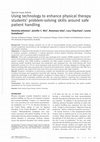
Physical Therapy Reviews
Background: Physical therapy students are at risk of musculoskeletal injuries during patient hand... more Background: Physical therapy students are at risk of musculoskeletal injuries during patient handling. Current guidelines recommend a risk management approach to reduce the likelihood of injury associated with patient handling. Objectives: To determine the benefits of online scenarios using scenario-based learning interactive (SBLiH) to enhance students' confidence in making decisions around patient handling techniques, including equipment, and in practical patient handling skills. Methods: Third year undergraduate and first year graduate-entry masters (GEM) students from the 2011 cohort of the physical therapy program at The University of Queensland received comprehensive training in patient handling. Only GEM students completed two SBLi patient scenarios. Students' confidence in selecting patient handling techniques and equipment was assessed pre-and post-training with three statements scored on a 10-cm visual analogue scale anchored from strongly disagree to strongly agree. Patient handling skills were assessed with a practical skill assessment. Student satisfaction with SBLi as a learning platform was determined with three items and a focus group with eight students. Results: Students' confidence in performing a patient risk assessment and selecting appropriate patient handling technique and equipment improved with training. However, the online scenarios provided no additional advantage to the GEM students' confidence in these tasks or in the practical skill assessment. GEM students were moderately satisfied with SBLi as a learning platform, reporting that it assisted their clinical preparation for the clinical environment and increased their awareness for safety of themselves and others. Conclusions: The online interactive scenarios provided no additional benefit but may assist student preparation for the clinical environment.
Physical Therapy Reviews, 2013

International Journal of Injury Control and Safety Promotion, 2013
This narrative review examines injuries sustained by soldiers undertaking occupational load carri... more This narrative review examines injuries sustained by soldiers undertaking occupational load carriage tasks. Military soldiers are required to carry increasingly heavier occupational loads. These loads have been found to increase the physiological cost to the soldier and alter their gait mechanics. Aggregated research findings suggest that the lower limbs are the most frequent anatomical site of injury associated with load carriage. While foot blisters are common, other prevalent lower limb injuries include stress fractures, knee and foot pain, and neuropathies, like digitalgia and meralgia. Shoulder neuropathies (brachial plexus palsy) and lower back injuries are not uncommon. Soldier occupational load carriage has the potential to cause injuries that impact on force generation and force sustainment. Through understanding the nature of these injuries targeted interventions, like improved physical conditioning and support to specialised organisations, can be employed.
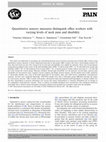
Pain, 2008
This study was undertaken to investigate any relationship between sensory features and neck pain ... more This study was undertaken to investigate any relationship between sensory features and neck pain in female office workers using quantitative sensory measures to better understand neck pain in this group. Office workers who used a visual display monitor for more than four hours per day with varying levels of neck pain and disability were eligible for inclusion. There were 85 participants categorized according to their scores on the neck disability index (NDI): 33 with no pain (NDI < 8); 38 with mild levels of pain and disability (NDI 9–29); 14 with moderate levels of pain (NDI ⩾ 30). A fourth group of women without neck pain (n = 22) who did not work formed the control group. Measures included: thermal pain thresholds over the posterior cervical spine; pressure pain thresholds over the posterior neck, trapezius, levator scapulae and tibialis anterior muscles, and the median nerve trunk; sensitivity to vibrotactile stimulus over areas of the hand innervated by the median, ulnar and radial nerves; sympathetic vasoconstrictor response. All tests were conducted bilaterally. ANCOVA models were used to determine group differences between the means for each sensory measure. Office workers with greater self-reported neck pain demonstrated hyperalgesia to thermal stimuli over the neck, hyperalgesia to pressure stimulation over several sites tested; hypoaesthesia to vibration stimulation but no changes in the sympathetic vasoconstrictor response. There is evidence of multiple peripheral nerve dysfunction with widespread sensitivity most likely due to altered central nociceptive processing initiated and sustained by nociceptive input from the periphery.

European journal of pain (London, England), 2009
This study investigated the relative contribution of individual, workplace, psychosocial and phys... more This study investigated the relative contribution of individual, workplace, psychosocial and physiological features associated with neck pain in female office workers towards developing appropriate intervention programs. Workers without disability (Neck Disability Index (NDI) score &amp;amp;amp;amp;amp;amp;amp;amp;amp;amp;amp;amp;amp;amp;amp;amp;amp;amp;amp;amp;amp;amp;amp;amp;amp;amp;amp;amp;amp;amp;amp;amp;amp;lt; or = 8, n=33); workers with neck pain and disability (NDI &amp;amp;amp;amp;amp;amp;amp;amp;amp;amp;amp;amp;amp;amp;amp;amp;amp;amp;amp;amp;amp;amp;amp;amp;amp;amp;amp;amp;amp;amp;amp;amp;amp;gt; or = 9/100, n=52) and 22 controls (women who did not work and without neck pain) participated in this study. Two logistic regression models were constructed to test the association between various measures in (1) workers with and without disability, and (2) workers without disability and controls. Measures included those found to be significantly associated with higher NDI in our previous studies: psychosocial domains; individual factors; task demands; quantitative sensory measures and measures of motor function. In the final model, higher score on negative affectivity scale (OR=4.47), greater activity in the neck flexors during cranio-cervical flexion (OR=1.44), cold hyperalgesia (OR=1.27) and longer duration of symptoms (OR=1.19) remained significantly associated with neck pain in workers. Workers without disability and controls could only be differentiated by greater muscle activity in the cervical flexors and extensors during a typing task. No psychosocial domains remained in either regression model. These results suggest that impairments in the sensory and motor system should be considered in any assessment of the office worker with neck pain and may have stronger influences on the presenting symptoms than workplace and psychosocial features.
The Australian journal of physiotherapy, 2009

Journal of electromyography and kinesiology : official journal of the International Society of Electrophysiological Kinesiology, 2015
Clinically, taping is believed to alter muscle activity. The purpose of this study was to investi... more Clinically, taping is believed to alter muscle activity. The purpose of this study was to investigate: (1) whether taping across the upper trapezius (UT) muscle influenced the level of UT and lower trapezius (LT) muscle activity and the ratio of these activities (UT/LT ratio) during a static typing task; and (2) if the activity of these muscles varied with the application of tensioned taping. Forty-two healthy participants performed a 15-min typing task on three separate occasions under one of three conditions: taping applied perpendicular to the UT fibers with tension; taping without tension; and no taping. Activity of the UT and LT muscles was assessed using surface electromyography. Between conditions, significant differences were found in the change of the normalized amplitude in the UT activity (p=.027) and UT/LT ratio (p=.024) but not in the LT activity (p=.93). Compared with the no taping condition, the UT activity was less in both the tensioned taping (p=.009) and the non-tensioned taping (p=.004). There was no difference between the two taping conditions in the change of the UT (p=.91) activity and the UT/LT ratio (p=.92). In conclusion, both tensioned and non-tensioned taping across the UT muscle reduces its activity during a typing task.

Applied ergonomics, 2015
Non-neutral wrist positions and external pressure leading to increased carpal tunnel pressure dur... more Non-neutral wrist positions and external pressure leading to increased carpal tunnel pressure during computer use have been associated with a heightened risk of carpal tunnel syndrome (CTS). This study investigated whether commonly used ergonomic devices reduce carpal tunnel pressure in patients with CTS. Carpal tunnel pressure was measured in twenty-one patients with CTS before, during and after a computer mouse task using a standard mouse, a vertical mouse, a gel mouse pad and a gliding palm support. Carpal tunnel pressure increased while operating a computer mouse. Although the vertical mouse significantly reduced ulnar deviation and the gel mouse pad and gliding palm support decreased wrist extension, none of the ergonomic devices reduced carpal tunnel pressure. The findings of this study do therefore not endorse a strong recommendation for or against any of the ergonomic devices commonly recommended for patients with CTS. Selection of ergonomic devices remains dependent on personal preference.
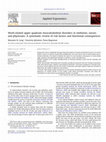
Applied Ergonomics, 2012
Background: Given a worldwide shortage of primary health care workers predicted to worsen, it is ... more Background: Given a worldwide shortage of primary health care workers predicted to worsen, it is vital to address sources of attrition among these professionals. One such source may be work-related musculoskeletal disorders. We aimed to identify risk factors for and functional consequences of work-related upper quadrant musculoskeletal disorders in midwives, nurses and physicians. Methods: Eighteen of 87 studies identified from an electronic database search met the inclusion and quality criteria. Results: Job demands, demanding work schedules and physical exposures have the strongest associations with work-related upper quadrant musculoskeletal disorders. Functional consequences included widespread use of prescription and over-the-counter medications and major negative impact on activities of daily living. No studies of midwives were located. Conclusion: High-quality studies of midwives as well as better-designed prospective studies of nurses and physicians are needed. Results of such studies could inform preventive strategies and reduce the contribution of work-related musculoskeletal disorders to attrition.
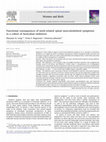
Women and Birth, 2013
Background: Early evidence suggests spinal musculoskeletal symptoms are as prevalent in Australia... more Background: Early evidence suggests spinal musculoskeletal symptoms are as prevalent in Australian midwives as in samples of nurses. Functional consequences of these symptoms include sick leave and functional incapacity, which are costly at both individual and workplace levels. To date there have been no studies of these consequences in midwives. Question: What risk factors are associated with sick leave and functional incapacity among midwives with spinal musculoskeletal symptoms? Methods: We undertook a cross-sectional study of qualified Australian midwives who completed the baseline survey of the Nurses and Midwives e-Cohort Study. A comprehensive set of independent variables were examined for bivariate associations with the main outcomes of sick leave and functional incapacity due to work-related musculoskeletal symptoms in the neck, upper or lower back. Associations that achieved a p value < .1 were entered into multiple logistic regression models. Findings: 729 midwives with a mean age of 46 years were eligible for inclusion. Functional incapacity was more than twice as common as sick leave. Severity of worst pain was the explanatory variable most strongly associated with each main outcome and the only one significant for both. Psychological job demands showed a significant association with sick leave, while several individual factors were associated with both outcomes. Only the association of poorer general health with functional incapacity remained significant in all three spinal regions. Conclusion: Our sample reported considerable work-related musculoskeletal pain and functional incapacity. Factors associated with sick leave and functional incapacity in midwives should be confirmed by longitudinal studies with the aim of developing tertiary prevention strategies.
Journal of Hand Therapy, 2014
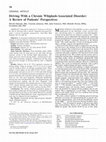
Archives of Physical Medicine and Rehabilitation, 2011
Takasaki H, Johnston V, Treleaven J, Pereira M, Jull G. Driving with a chronic whiplash-associate... more Takasaki H, Johnston V, Treleaven J, Pereira M, Jull G. Driving with a chronic whiplash-associated disorder: a review of patients' perspectives. Arch Phys Med Rehabil 2011;92:106-10. Objective: To document troublesome driving tasks and any changes in driving behavior reported by people with chronic whiplash-associated disorders (WADs). Design: Descriptive study; semistructured interview. Setting: Tertiary institution. Participants: Patients (Nϭ33) with chronic WAD. Interventions: Not applicable. Main Outcome Measures: Neck Disability Index (NDI), visual analog scale for neck pain at rest and while driving, exposure section of the Driving Habit Questionnaire, selfrating perceived current driving ability, semistructured interview about presenting symptoms, troublesome driving tasks, and perceived changes in driving behavior after a whiplash injury.

Archives of Physical Medicine and Rehabilitation, 2013
To establish an appropriate scoring system using Rasch scores for the strategic, tactical, and op... more To establish an appropriate scoring system using Rasch scores for the strategic, tactical, and operational levels of the Neck Pain Driving Index (NPDI) and to refine the NPDI by testing the unidimensionality of each driving performance level using Rasch analysis. Cross-sectional. Tertiary institution. Individuals with chronic whiplash-associated disorders (WAD) (N=123). Not applicable. The NPDI, which was developed to evaluate self-reported driving difficulty in people with chronic WAD. On the basis of Rasch analyses, modifications were made to the response format, changing it from a 0 to 4 scale (0=no difficulty, 1=slight difficulty, 2=moderate difficulty, 3=great difficulty, 4=unable to drive because of the injury) to a 0 to 3 scale (0=no difficulty, 1=slight difficulty, 2=moderate difficulty, 3=great difficulty and unable to drive because of the injury). Unidimensionality of the strategic and operational levels was confirmed. Modification of the tactical level was necessary to ensure its unidimensionality. After removing the tasks &amp;amp;amp;amp;amp;amp;amp;amp;amp;amp;amp;amp;amp;amp;amp;amp;amp;amp;amp;amp;amp;amp;amp;amp;amp;amp;amp;amp;amp;amp;quot;driving near (your) collision site,&amp;amp;amp;amp;amp;amp;amp;amp;amp;amp;amp;amp;amp;amp;amp;amp;amp;amp;amp;amp;amp;amp;amp;amp;amp;amp;amp;amp;amp;amp;quot; &amp;amp;amp;amp;amp;amp;amp;amp;amp;amp;amp;amp;amp;amp;amp;amp;amp;amp;amp;amp;amp;amp;amp;amp;amp;amp;amp;amp;amp;amp;quot;driving in a bad weather condition,&amp;amp;amp;amp;amp;amp;amp;amp;amp;amp;amp;amp;amp;amp;amp;amp;amp;amp;amp;amp;amp;amp;amp;amp;amp;amp;amp;amp;amp;amp;quot; and &amp;amp;amp;amp;amp;amp;amp;amp;amp;amp;amp;amp;amp;amp;amp;amp;amp;amp;amp;amp;amp;amp;amp;amp;amp;amp;amp;amp;amp;amp;quot;driving at night,&amp;amp;amp;amp;amp;amp;amp;amp;amp;amp;amp;amp;amp;amp;amp;amp;amp;amp;amp;amp;amp;amp;amp;amp;amp;amp;amp;amp;amp;amp;quot; unidimensionality of the 4-item tactical level was confirmed. A 9-item NPDI was established. A table converting raw total scores into Rasch scores was created for each level. This study established the 9-item NPDI, and its 3 subsections (strategic, tactical, and operational levels) are unidimensional. The magnitude of self-reported driving difficulty at each of the 3 subsections can be assessed with the use of a 0 to 3 scale and Rasch scores.

American Journal of Physical Medicine & Rehabilitation, 2014
Individuals with chronic whiplash-associated disorders (WADs) often note driving as a difficult t... more Individuals with chronic whiplash-associated disorders (WADs) often note driving as a difficult task. This study&amp;amp;amp;amp;amp;amp;amp;amp;amp;amp;amp;amp;amp;amp;amp;amp;amp;amp;amp;amp;amp;amp;amp;amp;amp;amp;amp;amp;amp;amp;amp;amp;amp;amp;#39;s aims were to (1) compare, while driving, neck motor performance, mental effort, and fatigue in individuals with chronic WAD against healthy controls and (2) investigate the relationships of these variables and neck pain to self-reported driving difficulty in the WAD group. This study involved 14 participants in each group (WAD and control). Measures included self-reported driving difficulty and measures of neck pain intensity, overall fatigue, mental effort, and neck motor performance (head rotation and upper trapezius activity) while driving a simulator. The WAD group had greater absolute path of head rotation in a simulated city area and used greater mental effort (P = 0.04), but there were no differences in other measures while driving compared with the controls (all P ≥ 0.05). Self-reported driving difficulty correlated moderately with neck pain intensity, fatigue level, and maximum velocity of head rotation while driving in the WAD group (all P &amp;amp;amp;amp;amp;amp;amp;amp;amp;amp;amp;amp;amp;amp;amp;amp;amp;amp;amp;amp;amp;amp;amp;amp;amp;amp;amp;amp;amp;amp;amp;amp;amp;amp;lt; 0.05). Individuals with chronic WAD do not seem to have impaired neck motor performance while driving yet use greater mental effort. Neck pain, fatigue, and maximum head rotation velocity could be potential contributors to self-reported driving difficulty in this group.
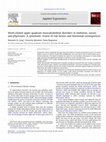
Applied Ergonomics, 2012
Background: Given a worldwide shortage of primary health care workers predicted to worsen, it is ... more Background: Given a worldwide shortage of primary health care workers predicted to worsen, it is vital to address sources of attrition among these professionals. One such source may be work-related musculoskeletal disorders. We aimed to identify risk factors for and functional consequences of work-related upper quadrant musculoskeletal disorders in midwives, nurses and physicians. Methods: Eighteen of 87 studies identified from an electronic database search met the inclusion and quality criteria. Results: Job demands, demanding work schedules and physical exposures have the strongest associations with work-related upper quadrant musculoskeletal disorders. Functional consequences included widespread use of prescription and over-the-counter medications and major negative impact on activities of daily living. No studies of midwives were located. Conclusion: High-quality studies of midwives as well as better-designed prospective studies of nurses and physicians are needed. Results of such studies could inform preventive strategies and reduce the contribution of work-related musculoskeletal disorders to attrition.

Uploads
Papers by Venerina Johnston